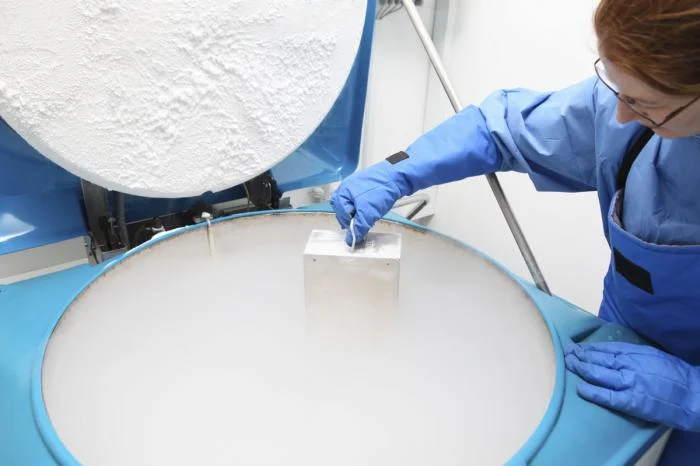Oocyte and Embryo Vitrification
Vitrification
Vitrification is a technology used in the embryo and egg freezing process so that they can be stored for future use. It is a technology that has many uses outside of fertility care with egg and embryo freezing, as it allows something with a crystalline structure to be converted into something very smooth.
When we freeze cells in a lab, the main focus of the process is avoiding ice crystal formation as the fluid in the cell cools to subzero temperatures. Ice crystals pose 2 significant and deadly problems for cells. First, an ice crystal is razor sharp and will readily shred any cell membrane. Second, as water in the cell turns to ice, it expands in volume, rupturing (killing) the cell. As a result, processes must be developed that allow cells to be frozen while avoiding the formation of ice.
Over the last few years there has been a worldwide shift to vitrification from slow freezing. At PFC, we began learning the vitrification process in 2006 and were so impressed that we have not slow frozen an embryo here since 2007.
The process of vitrification has 3 critical components. First, eggs or embryos are exposed to high concentrations of cryoprotectants to allow rapid dehydration of cells. Second, the eggs or embryos are loaded into tiny storage devices (usually straws) that will facilitate ultra-rapid cooling, and third, the straws containing the eggs/embryos are cooled as fast as possible, typically at thousands of degrees per minute.
This high cooling rate combined with the use of high concentrations of cryoprotectants allows the contents of the straw (embryos plus surrounding fluid) to turn to a glass like substance instead of ice. Avoiding ice formation in this way successfully protects the embryos from damage and allows them to be warmed later giving survival rates consistently above 90%.
When patients return to use their vitrified embryos or eggs, the vitrification procedure described above is reversed to allow warming back to room temperature and then 37°C, and to allow for rehydration. Since the eggs/embryos are not technically frozen (no ice was formed), we do not use the term "thawing" for this process. The procedure "warms" the eggs/embryos in just 20 minutes and they are placed back in the incubator at 37°C in the laboratory. Embryos can be transferred to the uterus immediately and eggs can be injected with a single sperm 3-4 hours later.
Procedures associated with vitrification
Assisted hatching
The cryoprotectants used in the vitrification process cause hardening of the zona pellucida, the glycoprotein shell that surrounds the egg and embryo. Since the embryo will have to escape from within the zona after it has been warmed and placed in the uterus, we will make a hole in the zona prior to transferring the embryo. This hole is made with a fine laser and it simply allows us to overcome the zona hardening that is characteristic of the vitrification process. The zona is a non-living part of the embryo, so no damage is caused by cutting a small escape hole.
ICSI
Intra cytoplasmic sperm injection (ICSI) is a procedure used to inject a single sperm into an egg. Normally this procedure is only used for patients that have poor sperm quality and when we suspect that sperm may not be able to fertilize eggs on their own. However, due to the hardening of the zona that occurs with vitrification, all vitrified eggs are fertilized using the ICSI procedure. The changes in the zona prevent sperm from penetrating in the normal way, and each egg has to be individually injected with a single sperm.




